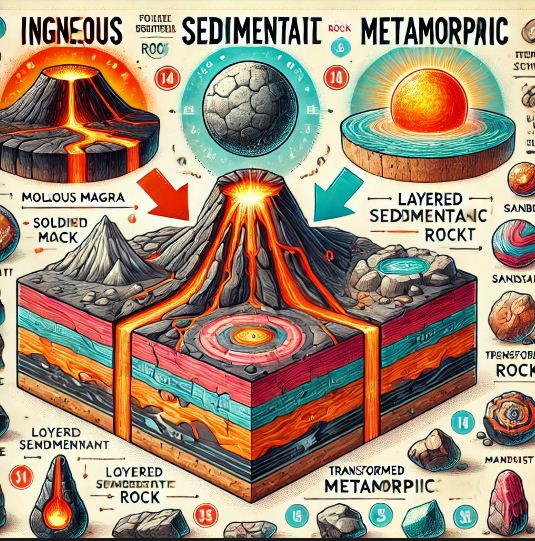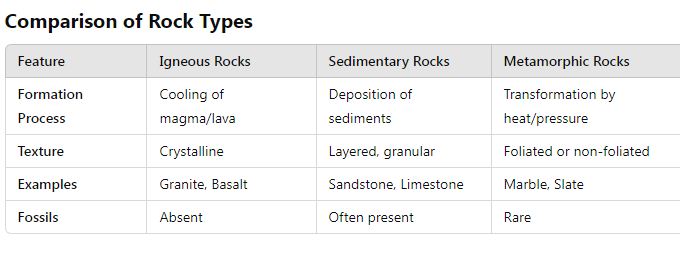January 4, 2025
What is Rock ? Types of Rocks:
A rock is a naturally occurring solid aggregate of minerals, mineraloids, or organic materials. Rocks form the fundamental building blocks of Earth’s crust and are classified based on their composition, texture, and the processes by which they are formed.
Types of Rocks:
- Igneous Rocks:
- Process of Formation:
- Formed through the cooling and solidification of magma or lava.
- Magma cools beneath the Earth’s surface (intrusive/plutonic rocks) or after being erupted from volcanoes (extrusive/volcanic rocks).
- Classification:
- Intrusive Igneous Rocks: Formed from magma that cools slowly beneath the Earth’s surface, resulting in large, visible crystals.
Examples: Granite, Diorite. - Extrusive Igneous Rocks: Formed from lava that cools rapidly on the surface, resulting in fine-grained textures.
Examples: Basalt, Obsidian, Pumice.
- Intrusive Igneous Rocks: Formed from magma that cools slowly beneath the Earth’s surface, resulting in large, visible crystals.
- Examples:
- Granite (intrusive)
- Basalt (extrusive)
- Key Features:
- Hard, dense, and crystalline.
- Lack of fossils due to high temperatures during formation.

- Process of Formation:
- Sedimentary Rocks
- Process of Formation:
- Formed through the deposition, compaction, and cementation of sediments over time.
- Sediments are derived from the weathering and erosion of pre-existing rocks.
- Layers accumulate in water bodies, and over time, pressure consolidates them into rock.
- Classification:
- Clastic Sedimentary Rocks: Composed of rock fragments and mineral grains.
Examples: Sandstone, Shale. - Chemical Sedimentary Rocks: Formed from precipitation of minerals from water.
Examples: Limestone, Rock Salt. - Organic Sedimentary Rocks: Formed from the accumulation of organic materials like plant and animal remains.
Examples: Coal, Chalk.
- Clastic Sedimentary Rocks: Composed of rock fragments and mineral grains.
- Examples:
- Sandstone, Shale, Limestone.
- Key Features:
- Often contain fossils.
- Typically layered (stratified).
- Process of Formation:
- Metamorphic Rocks:
- Process of Formation:
- Formed when existing rocks (igneous, sedimentary, or other metamorphic rocks) are subjected to high heat, pressure, or chemically active fluids.
- The mineral composition and texture of the rock change without melting.
- Classification:
- Foliated Metamorphic Rocks: Have a banded or layered appearance due to mineral alignment under pressure.
Examples: Slate, Schist, Gneiss. - Non-Foliated Metamorphic Rocks: Lack a layered appearance, with minerals arranged randomly.
Examples: Marble, Quartzite.
- Foliated Metamorphic Rocks: Have a banded or layered appearance due to mineral alignment under pressure.
- Examples:
- Slate (from shale), Marble (from limestone), Quartzite (from sandstone).
- Key Features:
- Dense and durable.
- May display foliation or recrystallization of minerals.

- Process of Formation:
Daily Gist : The Hindu/Indian Express : 30 Jan 2025
January 30, 2025
Gist of editorial : the Hindu/ Indian Express/20 Jan 2025
January 20, 2025
Daily the Hindu/ Indian Express Editorial Gist: 14 Jan 2025
January 14, 2025
